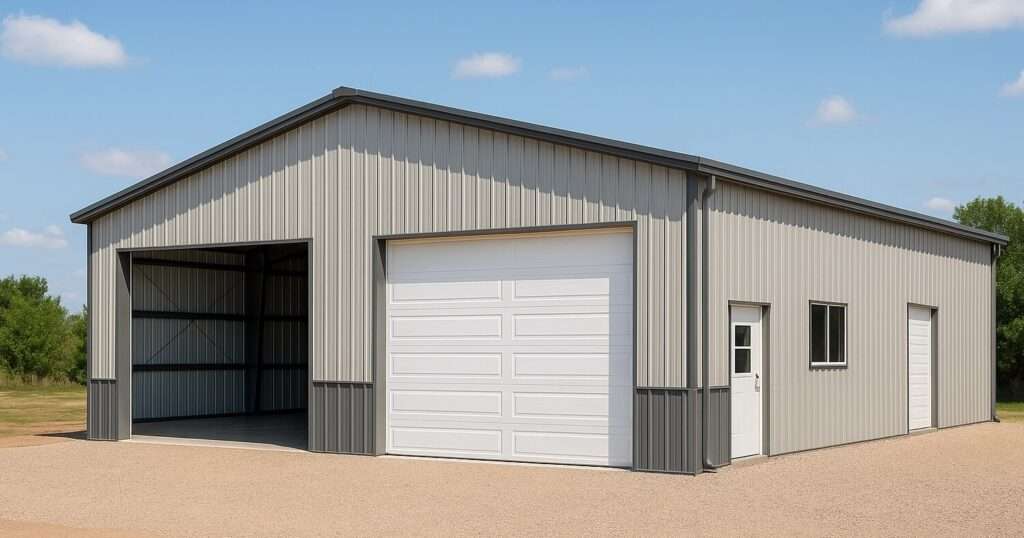In recent years, steel buildings have become the go-to solution for homeowners, business owners, and hobbyists looking to construct durable, functional, and cost-effective garage and shop spaces. Whether you’re storing vehicles, building a workshop, running a small business, or managing a farm, steel buildings offer unmatched flexibility and longevity.
We’ll explore why steel buildings are ideal for garages and shops, walk through the construction process, highlight key design considerations, and share tips for ensuring your project’s success.

Why Choose a Steel Building for Your Garage or Shop?
1. Durability and Strength
Steel is one of the strongest construction materials available. Unlike wood, it’s resistant to rot, warping, termites, and fire. A steel building can easily withstand harsh weather conditions, from heavy snow and strong winds to intense heat.
Many steel garage and shop structures are rated to last 50 years or more with minimal maintenance, making them a wise long-term investment.
2. Cost-Effectiveness
While the initial price per square foot of a steel building may be similar to or slightly more than traditional wood-frame buildings, the long-term savings are substantial. Reduced maintenance costs, lower insurance premiums, and energy-efficient options can dramatically lower your total cost of ownership.
Additionally, steel buildings are often quicker to erect, reducing labor costs and getting you into your space faster.
3. Design Flexibility
Modern steel buildings aren’t just boring boxes. With advancements in fabrication and finishing options, you can customize your garage or shop to meet your specific needs:
- Clear-span interiors with no interior columns
- Mezzanines or second-story storage
- Overhead doors, roll-up doors, and custom windows
- Skylights, insulation, HVAC systems
- Exterior finishes that mimic wood, brick, or stucco
You can create anything from a basic storage shed to a stylish, fully equipped workshop or auto shop.
4. Quick Construction Timeline
Pre-engineered steel building (PEB) kits are manufactured offsite and delivered ready for assembly. This dramatically reduces construction time compared to stick-built structures. A standard two- to four-car garage can often be erected in a matter of days.
Typical Uses for Steel Garage & Shop Buildings
Steel buildings are incredibly versatile. Here are some of the most common uses:
- Residential Garages – For everyday vehicle storage, project cars, motorcycles, and ATVs.
- Workshops – Ideal for woodworking, welding, fabrication, or mechanics.
- Commercial Shops – For contractors, landscapers, and service businesses needing a central operations base.
- Farm and Ranch Buildings – For storing equipment, tractors, feed, or housing animals.
- Recreational Storage – For boats, RVs, snowmobiles, and outdoor gear.
Step-by-Step Guide to Building a Steel Garage or Shop
Step 1: Define Your Purpose and Needs
Start by identifying what you need from the building. Ask yourself:
- What size garage or shop do I need?
- How many bays or overhead doors?
- Do I need climate control?
- Will I need storage lofts, offices, or bathrooms?
Your answers will guide the design process and ensure your building is tailored to your unique requirements.
Step 2: Choose a Reputable Steel Building Supplier
Selecting a trusted manufacturer or supplier is critical. Look for companies with:
- Experience in your area (knowledge of local codes and climate)
- Strong customer reviews
- Clear warranties and support
- Pre-engineered kits tailored to your zoning and permitting needs
Some of the top steel building brands in North America include General Steel, Mueller, Morton Buildings, and Worldwide Steel Buildings.
Step 3: Secure Permits and Local Approvals
Most municipalities require building permits, especially for garages and shops connected to utilities or over a certain square footage. Your contractor or steel building provider should assist with:
- Site plans and engineered drawings
- Local building codes
- Snow load, wind load, and seismic considerations
It’s also important to check setback requirements, zoning restrictions, and HOA rules (if applicable).
Step 4: Prepare the Site and Foundation
Before your steel building kit arrives, you’ll need to prepare the site. This includes:
- Leveling and grading the land
- Pouring a concrete slab foundation (or piers, depending on the design)
- Installing drainage or underground utilities as needed
A proper foundation is essential for the structural integrity of your steel building.
Step 5: Assemble the Building
Once the materials arrive, the building is assembled in sections:
- Erect the framing – Steel columns and beams are bolted together to form the skeleton.
- Install the wall and roof panels – Typically corrugated or ribbed steel panels.
- Add doors, windows, and trim – Roll-up or sectional doors, walk-in doors, windows, etc.
- Insulate and finish the interior – If applicable, add insulation, electrical, HVAC, drywall, or storage systems.
A professional steel building crew can typically complete a small-to-medium garage in one to two weeks.
Design Tips and Customization Options
- Insulation Matters – Steel buildings conduct heat and cold, so insulation (like spray foam or vinyl-backed fiberglass) is vital for comfort and energy efficiency.
- Lighting and Ventilation – Consider skylights, ridge vents, and large windows to maximize natural light and airflow.
- Overhead Doors – Match door sizes to your equipment or vehicles. Consider remote openers and insulated doors.
- Interior Layout – Think about workflow, tool placement, and storage. Use vertical space with shelves and racks.
- Exterior Aesthetics – Add fascia, wainscoting, or decorative trim for curb appeal. Many homeowners opt for faux-wood finishes to match the house.
Common Mistakes to Avoid
- Underestimating Space – Always plan for a little more square footage than you think you need. You’ll use it.
- Skipping the Permit Process – Fines and teardown orders can result from unpermitted construction.
- Cutting Corners on the Foundation – A bad slab means structural issues. Invest in quality.
- Poor Site Drainage – Steel buildings are waterproof, but improper grading can lead to flooding or erosion around the base.
- DIY Without Experience – While some kits are DIY-friendly, complex projects benefit from experienced crews.
Steel garages and shop buildings are no longer just for industrial use — they’re a smart, stylish, and sustainable option for homeowners, entrepreneurs, and farmers alike. With their speed of construction, low maintenance needs, and customizable design options, they offer unmatched value for almost any use case.
Whether you’re a weekend mechanic, a full-time contractor, or someone needing a reliable place to store tools and toys, a steel building provides the strength and flexibility to grow with your needs.
Need help designing your ideal steel garage or shop? Contact us today to learn how we can bring your vision to life — from initial design through final construction.
